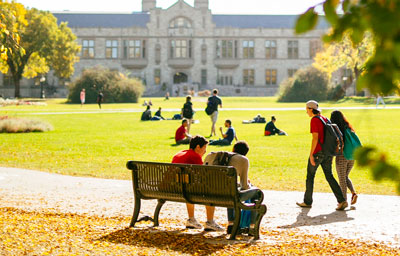About
The Certificate in Computing provides fundamental skills in theory, design, development and application of software and systems that will support you and your work in a variety of scenarios.
- Two-year certificate
- Part-time program
- You can enter this program directly from high school
What you will learn
This program provides a foundation for programming and software development. Although not intended to prepare students for careers in software development, you will learn many practical day-to-day programming and software development skills that will benefit you in your own problem-solving and technical abilities. You will better understand the technology used in most workplaces and have tools which will allow you to be more creative and productive in almost any area of employment.
CMPT 214.3: Programming Principles and Practice
A hands-on approach to software development at the individual and small team level. Application of software tools- including scripting languages, system utilities and libraries- for construction of small software systems. Integrated with and motivated by programming practices, system development, testing and maintenance issues.
CMPT 370.3: Intermediate Software Engineering
Principles and techniques for developing software combined with the practical experience of creating a mid-size software system as a member of a software development team. Includes: teamwork; projects, planning and process; users and requirements; use cases; modelling; quality; software architecture; testing; GUI design, design principles, patterns and implementation; ethics; professionalism.
CMPT 384.3: Information Visualization
This course will introduce visualization process for different datasets, design principals, techniques for developing effective visualizations, visualization algorithms and interaction techniques. The course is targeted to students interested in using visualization in their own work, as well as to those who are interested in developing visualization systems. Topics include: data abstractions, visualization process, design principles, visualizations of tabular data, geo-visualizations, cartographic representation, visualization for sets, temporal and hierarchical data (treemaps, radial layouts), network visualizations, visualization algorithms and software, interactions with large datasets, and a brief overview of visual analytics.
The Course and Program Catalogue has the complete and official listing of required classes and their descriptions for this program.
Our faculty undertake primary research in the field and shares discoveries and processes with our students. They are excited about the dynamic discipline of Computer Science and explore new ways in which computing can change the lives of people everywhere. They provide solid classroom instruction and offer laboratory experience in state-of-the-art facilities.
Careers
Qualified computer scientists are in high demand and many professions need people who also have computing skills, especially those who work in technical fields or are involved in science and research. This includes engineers, scientists, business professionals and future educators who would be interested in teaching computer science at the K-to-12 levels. Successful completion of the Certificate in Computing will be an attractive complementary credential and give you an advantage in the job market.
Tuition estimates
| Canadian students | International students | |
|---|---|---|
| Tuition | $944.70 per 3 credit unit class | $4,572.30 per 3 credit unit class |
| Student fees | $1,308.24 per year | $1,308.24 per year |
Tuition will vary depending on the type and number of classes you take in a year. This estimate reflects a typical amount you could expect to pay per class (2025-2026 Canadian dollar rates).
Student fees are used to fund specific student benefits, including health, vision and dental coverage, a bus pass, recreational programs and fitness centre access. This estimate reflects the price you would pay if you are a full-time student.
The cost of books and supplies varies widely depending on the courses you choose. It is recommended that you budget between $1,500-$2,500 for this program.
Program options

The Certificate in Computing is offered by the University of Saskatchewan's College of Arts and Science. You may earn the certificate on its own, while pursuing a degree, or after graduating with a degree.
If you are already enrolled at USask, consult your academic advisor regarding enrolling in this program.
The Course and Program Catalogue has the complete and official listing of required classes and their descriptions for this program.
International students:
-
The College of Arts and Science strongly recommends that international students do not enrol in a certificate program alone, as course offerings per term and program length may not be sufficient to maintain eligibility for a study permit, on/off-campus work permit, or post-graduation work permit when taken as a stand-alone program.
If you are interested in pursuing a certificate program, plan to enrol in your certificate of interest only alongside a degree. Learn more by visiting the International Student Guide and connect with an academic advisor if you are interested in adding a certificate to your degree program after you become a student!
- International Student Guide
- Academic advising
Admission requirements
Your information
Admission requirements depend on your situation; please tell us about yourself.
Application deadlines
| Start term | Application deadline | International deadline |
|---|---|---|
|
Winter January 2026 |
Dec. 1, 2025 Documents due: Dec. 15, 2025 |
Sept. 1, 2025 Documents due: Oct. 1, 2025 |
|
Spring May 2026 |
April 1, 2026 Documents due: May 1, 2026 |
Feb. 1, 2026 Documents due: March 1, 2026 |
|
Summer July 2026 |
May 1, 2026 Documents due: June 1, 2026 |
March 1, 2026 Documents due: April 1, 2026 |
|
Fall September 2026 |
July 15, 2026 Documents due: Aug. 1, 2026 |
May 1, 2026 Documents due: June 1, 2026 |
|
Winter January 2027 |
Dec. 1, 2026 Documents due: Dec. 15, 2026 |
Sept. 1, 2026 Documents due: Oct. 1, 2026 |
Ready to apply?
If you are a current USask student, consult your academic advisor about enrolling in this program.
To apply to this program as a new student, create an admissions account and apply for admission to any undergraduate program in the College of Arts and Science. When you are ready to submit your application, you will be assessed a non-refundable application fee of $120 CAD. After you are admitted, declare your plans to the college.
Related programs
If you are looking for graduate level (master's or Ph.D.) programs please consult our graduate students' website.

If you are interested in more information about this certificate, please contact student-advice@artsandscience.usask.ca

